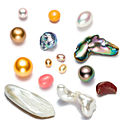Bibliography
Notes
- 1 2 Hurlbut & Kammerling 1991, p. 203.
- ↑ "Emerald Quality Factors". GIA.edu. Gemological Institute of America. Archived from the original on November 2, 2016. Retrieved November 1, 2016.
- ↑ Giuliani G, Chaussidon M, Schubnel HJ, Piat DH, Rollion-Bard C, France-Lanord C, Giard D, de Narvaez D, Rondeau B (2000). "Oxygen Isotopes and Emerald Trade Routes Since Antiquity" (PDF). Science. 287 (5453): 631–3. Bibcode:2000Sci...287..631G. doi:10.1126/science.287.5453.631. PMID 10649992. Archived (PDF) from the original on August 7, 2011.
- ↑ "Romans organized the mines as a multinational business..." Finlay, Victoria. Jewels: A Secret History (Kindle Location 3098). Random House Publishing Group. Kindle Edition.
- ↑ Badawy, Manuela (June 13, 2012). "Emeralds seek the 'De Beers' treatment". Reuters. Archived from the original on August 5, 2012. Retrieved June 14, 2012.
- ↑ Dydyński, Krzysztof (2003). Colombia. Lonely Planet. p. 21. ISBN 0-86442-674-7.
- ↑ Branquet, Y. Laumenier, B. Cheilletz, A. & Giuliani, G. (1999). "Emeralds in the Eastern Cordillera of Colombia. Two tectonic settings for one mineralization". Geology. 27 (7): 597–600. Bibcode:1999Geo....27..597B. doi:10.1130/0091-7613(1999)027<0597:EITECO>2.3.CO;2.
{{cite journal}}: CS1 maint: multiple names: authors list (link) - ↑ Carrillo, V. (2001). Compilación y análisis de la información geológica referente a la explotación esmeraldífera en Colombia. Informe de contrato 124. INGEOMINAS
- ↑ Wacaster, Susan (March 2012). "2010 Minerals Yearbook: Colombia [ADVANCE RELEASE]" (PDF). United States Geological Survey. Archived (PDF) from the original on August 13, 2012. Retrieved August 7, 2012.
- ↑ Emerald Mining Areas in Colombia Archived September 29, 2010, at the Wayback Machine , with location map of these three districts.
- ↑ Zambia, Mining For (2019-10-02). "Five reasons Zambia's emeralds are in the global spotlight -". Mining For Zambia. Retrieved 2021-12-08.
- ↑ "A land called kagem". 28 March 2024.
- ↑ Martin, Will (2021-08-02). "Monthly Operational Market Update – 30 June 2021 | Gemfields Group" . Retrieved 2021-12-08.
- ↑ "Introducing Imboo – the 11,685 carat 'buffalo' emerald". gemfields.com. 26 August 2025. Retrieved 2025-10-19.
- ↑ "Gemfields discovers one of the world's largest emeralds weighing 1.5 kg". Business Today. 13 November 2021. Retrieved 2021-12-08.
- ↑ Slater, Donna. "Gemfields unearths largest gem to date at Kagem, names it Chipembele". Mining Weekly. Retrieved 2021-12-08.
- ↑ "Gemfields makes another startling discovery – a 7,525 ct rhino emerald named Chipembele". DiamondWorld.net. Retrieved 2021-12-08.
- ↑ DeMarco, Anthony. "A 5,655-Carat Emerald Discovered In Zambia". Forbes. Retrieved 2021-12-08.
- ↑ "Gemfields discovers exceptional 6,225 carat 'insofu' emerald at Kagem Mine, Zambia". Proactiveinvestors UK. 2010-02-22. Retrieved 2021-12-08.
- ↑ Allen 2010.
- ↑ Weil 2017.
- ↑ Gast 2010.
- ↑ Stancill 2012.
- ↑ Smithsonian Institution 2019.
- ↑ American Museum of Natural History 2019.
- ↑ Boulliard 2016.
References
- Allen, Nick (September 24, 2010). "Judge to decide who owns £250 million Bahia emerald". The Daily Telegraph . Retrieved August 31, 2019.
- American Museum of Natural History (2019). "Patricia Emerald". American Museum of Natural History . Retrieved August 31, 2019.
- Boulliard, Jean-Claude (2016). 101 minéraux et pierres précieuses qu'il faut avoir vus dans sa vie (in French). PUBLISHER. ISBN 9782100742271.- Total pages: 240
- Gast, Phil (September 1, 2010). "North Carolina emerald: Big, green and very rare". CNN. Archived from the original on September 25, 2013. Retrieved August 31, 2019.
- Hurlbut, Cornelius S.; Kammerling, Robert C. (1991). Gemology. Wiley. ISBN 9780471526674.- Total pages: 352
- Smithsonian Institution (2019). "Gachala Emerald". Smithsonian Institution . Retrieved August 31, 2019.
- Stancill, Jane (March 17, 2012). "N.C. gems to shine at museum". The News & Observer Publishing Co. Archived from the original on March 27, 2012. Retrieved August 31, 2019.
- Weil, Elizabeth (March 2, 2017). "The Curse of the Bahia Emerald, a Giant Green Rock That Ruins Lives". Wired . Retrieved August 31, 2019.



